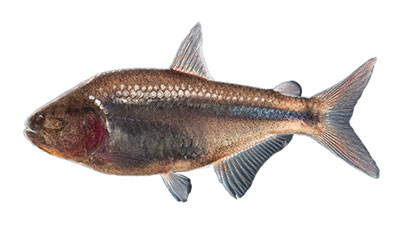Purpose
The Institute for Creation Research is engaged in our biggest science initiative in the last two decades, and it could be our most important undertaking to date. We’re working on model organisms and producing literature to build a theory of biological design (TOBD) that will fundamentally change how biological phenomena are interpreted.
Why is theory so important? A theory is a working hypothesis that logically compiles observations about something into an explanation about its origin or how it works. A plausible theory can actually change a person’s worldview. Darwin’s theory moved millions of people away from belief in a theistic origin for organisms. Dr. Henry M. Morris’ model of Flood geology changed how geological features are interpreted and pointed millions back to a clear understanding of the historical biblical narrative.1 But where’s the creationist theory of biology that, for instance, models how biological adaptation operates like it was truly engineered?
Why is a TOBD urgently needed? First, if creationists and Intelligent Design advocates say that creatures look designed because they are designed, then we need a working theory of engineered biology—not just a focus on identifying problems with evolution. Second, ICR’s longstanding model of adaptation was only a lighter version of evolution.2 Finally, a theory is a framework that constrains how we interpret data and formulate explanations. It guides the questions we ask and what we predict to find. Thus, a TOBD is paramount to setting ICR’s innovative biological research agenda.
Methods
Theory building begins with field observations and questions. Biological adaptation is central to evolution, so we decided to use adaptation as the first model for our theory of biological design. We observe that when environments change, creatures often rapidly express complex traits that are highly suitable to the new conditions.
What enables these organisms to so quickly and efficiently adjust to changing external circumstances? Where should we look to discover how these changes happen— to something in the environment or to innate mechanisms within the organisms themselves? How did this adaptive process originate? Can nature function as an agent sufficient unto itself, or is an intelligent agent needed? Building a theory to answer these questions involves the following steps.
Interpretation. A TOBD assumes that creatures are engineered entities. Three major tenets guide ICR’s interpretations of findings.
- Intentionality—all traits function purposefully.
- Individuality—like all engineered entities, organisms should be studied as discreet individuals delineated by definite boundaries. Organisms are autonomous agents.
- Internalistic—the operation of all biological functions arises from identifiable control systems innate to organisms.
Expectations and Explanations. Engineering-based, organism-focused assumptions shift ICR to a radically differently approach to biology than evolutionary biologists take. This is a necessary departure from the status quo so researchers can have the latitude to seek accurate explanations rather than rely on mutation-selection assumptions.
ICR holds that basic biological research is within the domain of engineering practice. Analyzing human engineering practices will inform research predictions. Thus, we expect corresponding system elements between human-designed devices and biological mechanisms performing similar functions. We expect that adaptation overwhelmingly occurs through purposeful modifications and not via mutation and broken systems. ICR crafts explanations positing that biological functions can be accurately explained by models that are developed utilizing engineering principles.
Continuous environmental tracking (CET) is ICR’s engineering-based, organism-focused model of adaptation.3 CET hypothesizes that organisms possess innate systems that actively and autonomously track changing conditions using system elements that are similar to those found in human-engineered tracking systems. As we research literature and model organisms, we search for sensors to detect changing conditions, if-then logical algorithms, and output responses in the form of suitably modified traits.
Results

Research findings from our initial tests on blind cavefish support CET.4 The striking reduction in eyes and skin pigmentation in blind cavefish stands out when compared to sighted surface fish of the same species. Evolutionists claim these are a loss of functions due to broken genes.
In contrast, the CET model hypothesizes that these are modifiable traits that may be “dialed up or down” as needed. Our work demonstrates that within a month, cavefish can regain pigmentation when placed in simulated river conditions, and surface fish lose pigment when placed in simulated cave water. It’s significant to note that no fish died. Studies on eye modification will start soon.
Impact
Our fish results already show the power of an engineering-based model like CET to prompt a new world of research questions we would have otherwise missed. Freed from the shackles of Darwin’s death-driven selectionism, we no longer need to force-fit Darwin’s thinking into the Bible by looking to the Fall and the curse of death to explain adaptation.
By seeking the Creator’s originally designed purpose and mechanisms for adaptation, a new perspective opens that sees creatures as active, problem-solving entities that detect and solve very challenging environmental conditions through their spectacularly engineered, innate capacities—all to the glory of the Lord Jesus.
References
- Morris III, H. M. 2011. A Flood of Influence: The Impact of Henry Morris and The Genesis Flood in Modern History. Acts & Facts. 40 (2): 4-5.
- Guliuzza, R. J. 2023. Mutation-Selection: A Calamitous Creationist Concession. Acts & Facts. 52 (3): 4-7.
- Guliuzza, R. J. 2019. Engineered Adaptability: Continuous Environmental Tracking Wrap-Up. Acts & Facts. 48 (8): 17- 19. For more information, visit ICR.org/CET.
- See “CET: Testing the Cavefish Model.”.
* Dr. Guliuzza is President of the Institute for Creation Research. He earned his Doctor of Medicine from the University of Minnesota, his Master of Public Health from Harvard University, and served in the U.S. Air Force as 28th Bomb Wing Flight Surgeon and Chief of Aerospace Medicine. Dr. Guliuzza is also a registered Professional Engineer and holds a B.A. in theology from Moody Bible Institute.













